After the pleasant relaxation that ensued following the lunch when I read one of the couple of second-hand books I bought on Caye Caulker, I went to the room where I washed the sea salt off my body and then I went back again to the agency that I had already spoken about the possible excursion to the Lighthouse Reef. They had previously told me they were not sure if there would be enough interested people for the trip to be organised and that I should come back later on, which was exactly what I was doing now.
To my great delight, a sufficient number of them had already registered for the trip organised for the next day, so I signed up myself, too. The Lighthouse Reef was one of the two things I wanted to see during my stay in Belize and the other thing was the Great Blue Hole. What I had not realised before we had talked about the details of the trip was that the Great Blue Hole was in fact a part of the Lighthouse Reef, meaning that I would see both of the places that I wanted on the same day. This was a wonderful piece of news and I was exceptionally content when I paid for the trip and agreed the details concerning the departure of the following day.
Then I walked a little around Caye Caulker Village, after which I returned to the hotel where I sat on the beach for a while. By the way, when I say hotel, I’m thinking of several smaller wooden houses in which there were rooms, while the reception and the restaurant were in a separate house. Nothing was big and impressive, but it was more than enough for me.
I had to go to the reception a couple of times in order to leave my valuables in the hotel’s safe, but practically I spent the rest of the day sitting by the sea, reading a little, writing my travel diary a little and I also had another beer later on. This relaxation mode felt very good. Although it was quite windy, it was still beautifully warm, the waves that were not big created a lovely sound and there was a mild and pleasant scent of the sea. Even when the night fell I enjoyed sitting there and as there was a street lamp nearby, it was not too dark, since there was no moonlight at the time.
However, I felt sleepy quite early for I probably still felt the need to make up for the lack of sleep of two days ago, so I withdrew to my room and went to bed. After all, I had to get up very early the next morning anyway.
The reason for getting up early was that the excursion was starting already at 6 o’clock. So, that morning I woke up before the alarm clock again, but I continued snoozing until 5 am. Then I got up without any rush, got ready and went to the agency where we first gathered and then we embarked on a larger speedboat, after which we started off.
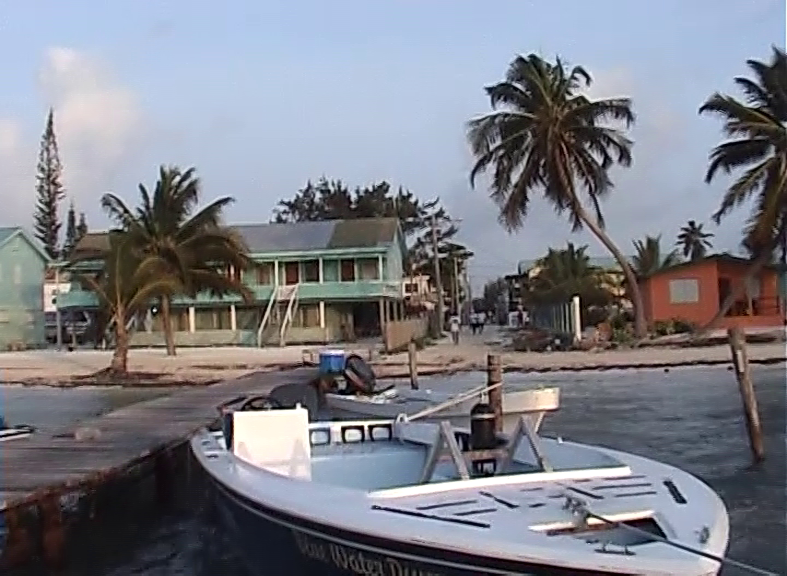 View at Caye Caulker from the speedboat very early in the morning
View at Caye Caulker from the speedboat very early in the morning
The Belize Barrier Reef, which is a part of the Mesoamerican Barrier Reef System, is around 300 km long and it extends along the coast of the entire country. There is some data that says that the Mesoamerican Barrier Reef System is the second largest reef in the world, but it all depends on how one gauges this and so some other data does not corroborate it. On the other hand, no matter what its size is, the part that belongs to Belize makes some 30% of the Mesoamerican Barrier Reef System.
In addition to the reef complex, three large atolls also belong to Belize. Within all of this, there are seven protected areas that stand out by their importance and quality and as a cluster of reserves and natural monuments they have been inscribed on the UNESCO’s World Heritage List as a natural property under the joint name of Belize Barrier Reef Reserve System. Put together, these seven protected areas account for 12% of the overall reef complex and on this day I was going to visit two of them.
Both of these protected areas are within the atoll called the Lighthouse Reef and our first destination was precisely the Great Blue Hole that I have already mentioned. Along the way it was choppy, it was all shaking and there was splashing all over the place, but it felt good. Although the speedboat went quite fast, bearing in mind that the Great Blue Hole is around 70 km away from Caye Caulker, it took us around two hours to get there.
Now, let me explain what this is about. The Blue Hole Natural Monument is one of those seven protected areas within the Belize Barrier Reef Reserve System. The Great Blue Hole is a fantastic natural phenomenon. During the geological history of our planet, once upon a time there used to be a cave in this place that got submerged over time and then its roof collapsed, thus creating a hole. And that would not be unusual at all, if the entrance into that hole did not have a perfectly circular shape when seen from the air – a fantastic marine blue dot surrounded by a thin turquoise line where the water is shallower, then by a brownish-green belt where the elevated part of the reef is, then turquoise again, etc. On the internet one can see numerous photographs and they all look extremely impressive, but when the person is at the level of the sea that impressiveness is simply not there. Knowing what this was all about, I could guess what exactly was around me, but had I not seen the photos before, I would have been unable to conclude much by just looking around.
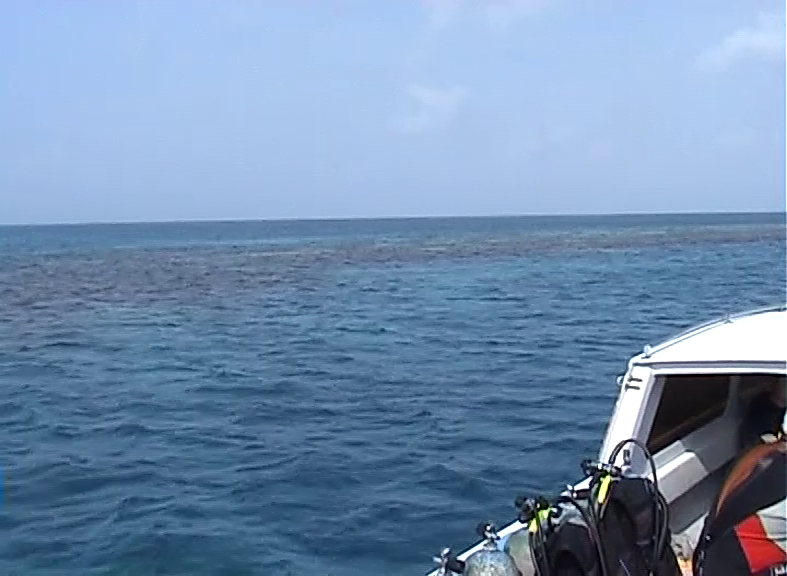 Parked within the Great Blue Hole – the darker belt is in fact the coral reef “ring”
Parked within the Great Blue Hole – the darker belt is in fact the coral reef “ring”
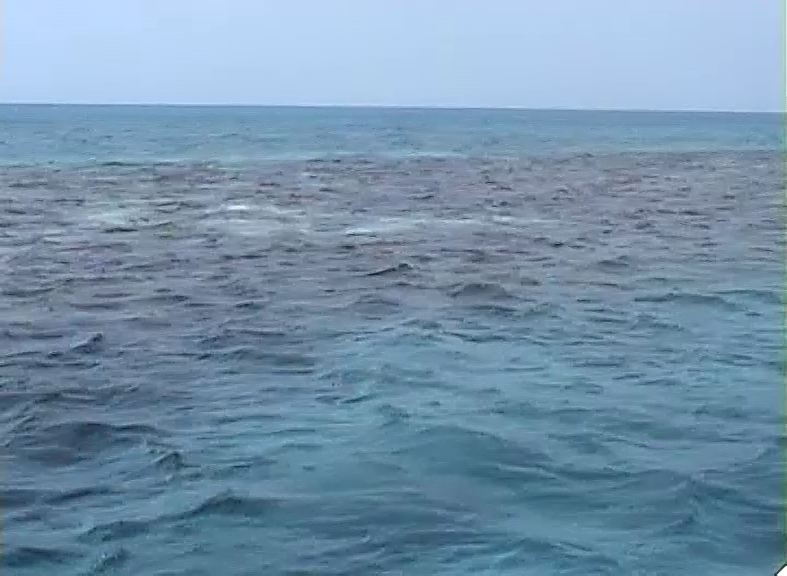 The coral reef “ring” that surrounds the Great Blue Hole
The coral reef “ring” that surrounds the Great Blue Hole
As our motorboat was parked above the edge of the hole, it was possible to see below us the shallower belt covered in sand that goes from the hole to the corals that create a ring around the Great Blue Hole.
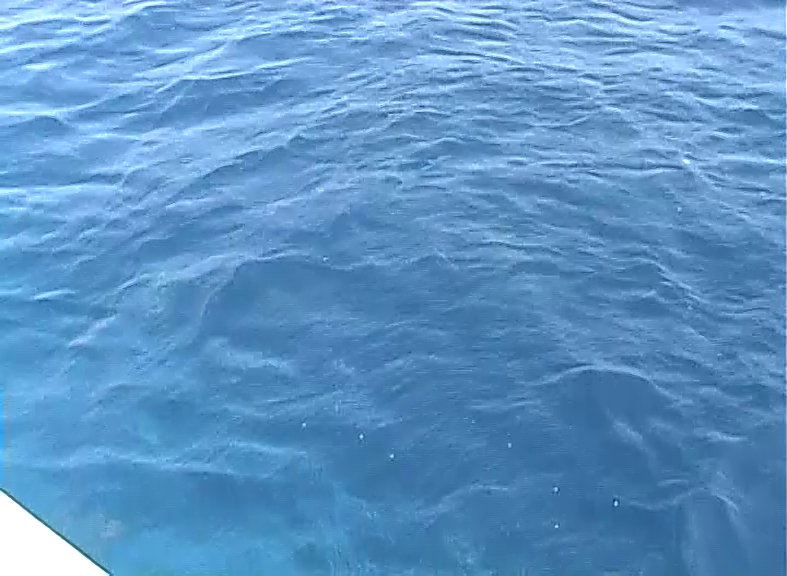 The left-hand side is lighter blue, which suggests sand; most of the photo is a part of the Great Blue Hole
The left-hand side is lighter blue, which suggests sand; most of the photo is a part of the Great Blue Hole
But, when I looked out towards the horizon over the Great Blue Hole, practically nothing suggested the phenomenon that is so picturesque when seen from the air.
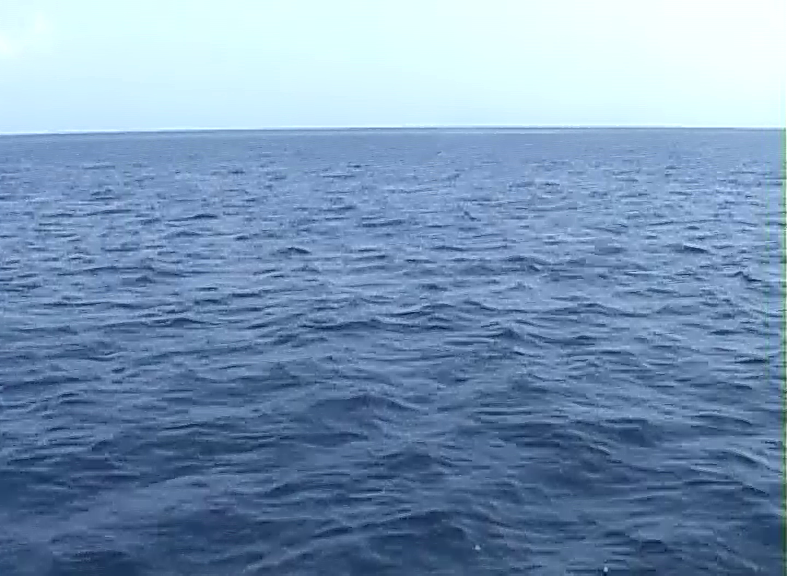 Great Blue Hole seems like any other deep blue sea
Great Blue Hole seems like any other deep blue sea
The Great Blue Hole has the diameter of 318 metres and it is 124 metres deep. It became famous in 1971 when famous Jacques Cousteau dived here. In fact, the majority of the group with whom I came on this excursion, the five of them, were here in order to go scuba diving, while one girl and I went snorkelling. They may have been more advanced as regards the diving method, but I was not bad altogether. I had my own special underwater photo-camera. While the scuba divers were getting ready still on the boat, I was already in the water and thrilled.
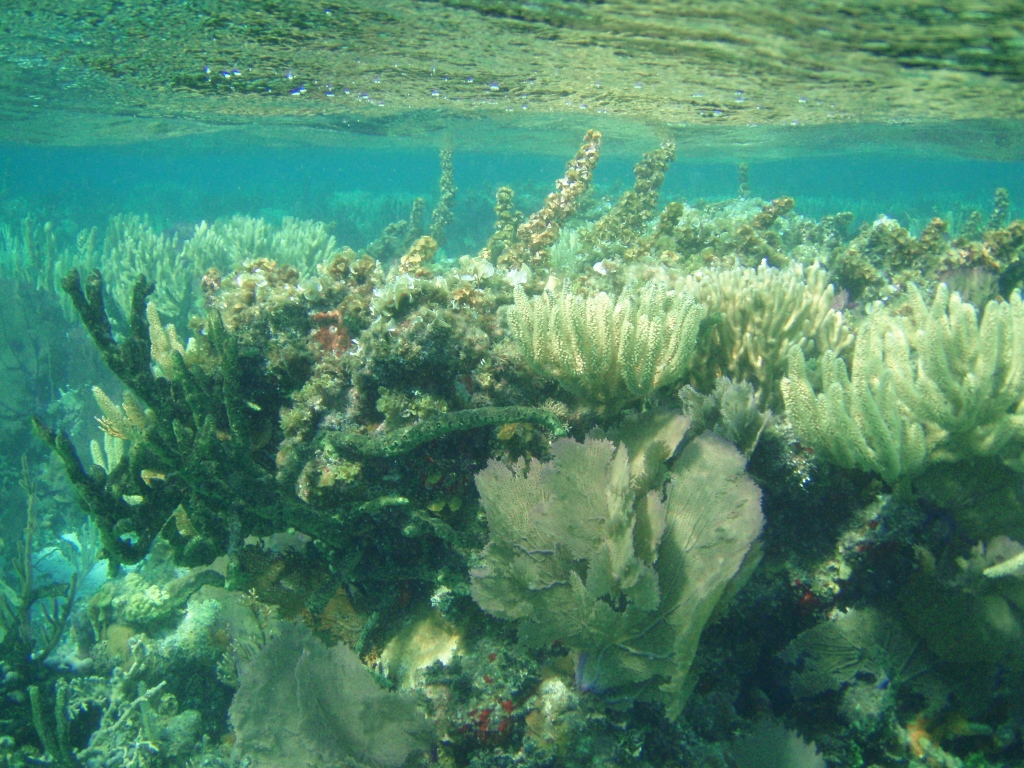 Part of the corals surrounding the Great Blue Hole
Part of the corals surrounding the Great Blue Hole
I must admit that I expected to see more of the colourful fish, but there were not that many. Here and there I could see some, but then they were not as colourful as I would have preferred. Still, the feeling of deep satisfaction was certainly present.
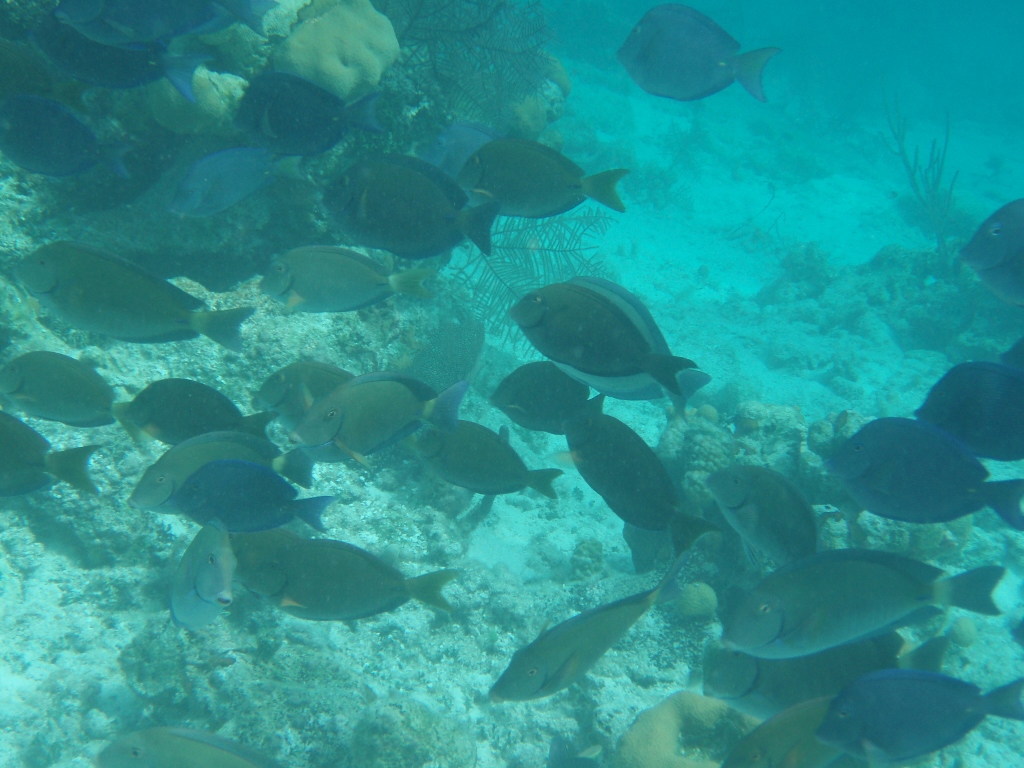 The sloping part that leads from the elevated coral reef zone towards the Great Blue Hole
The sloping part that leads from the elevated coral reef zone towards the Great Blue Hole
And then I took advantage of the presence of that other girl who also snorkelled here and so she took a photo of me.
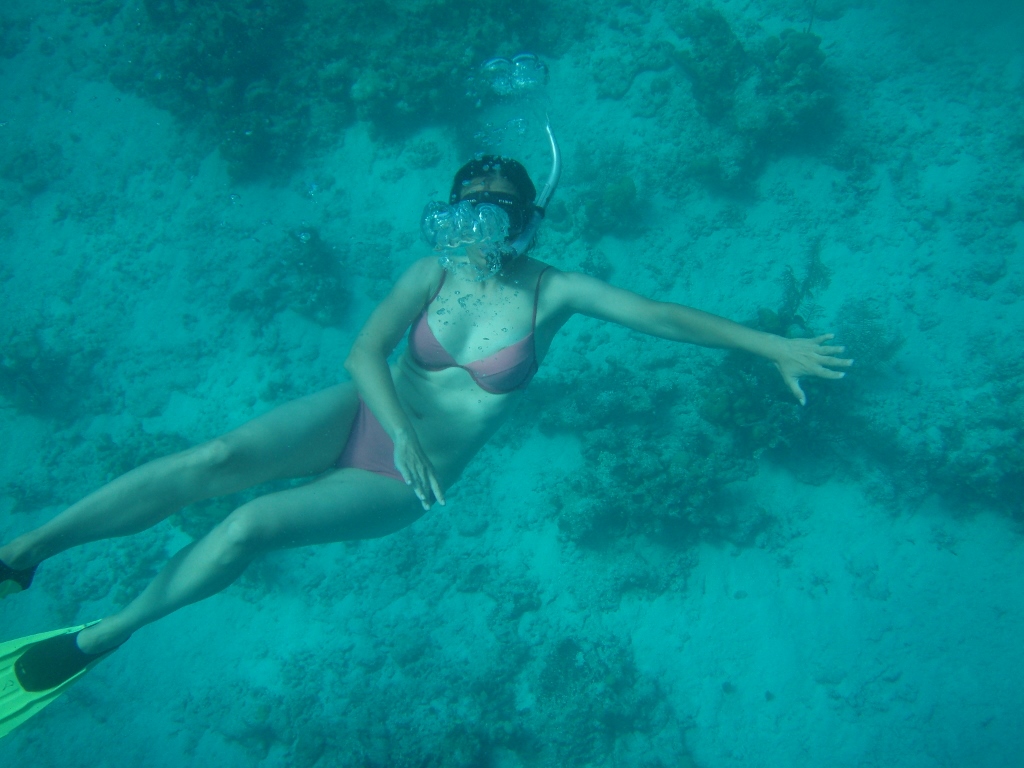 Posing by the Great Blue Hole
Posing by the Great Blue Hole
While I was snorkelling, taking photos and being photographed, the scuba divers were ready and they started to dive down into the Great Blue Hole. A girl from Argentina asked me to take a photo of her, which I did with great pleasure.
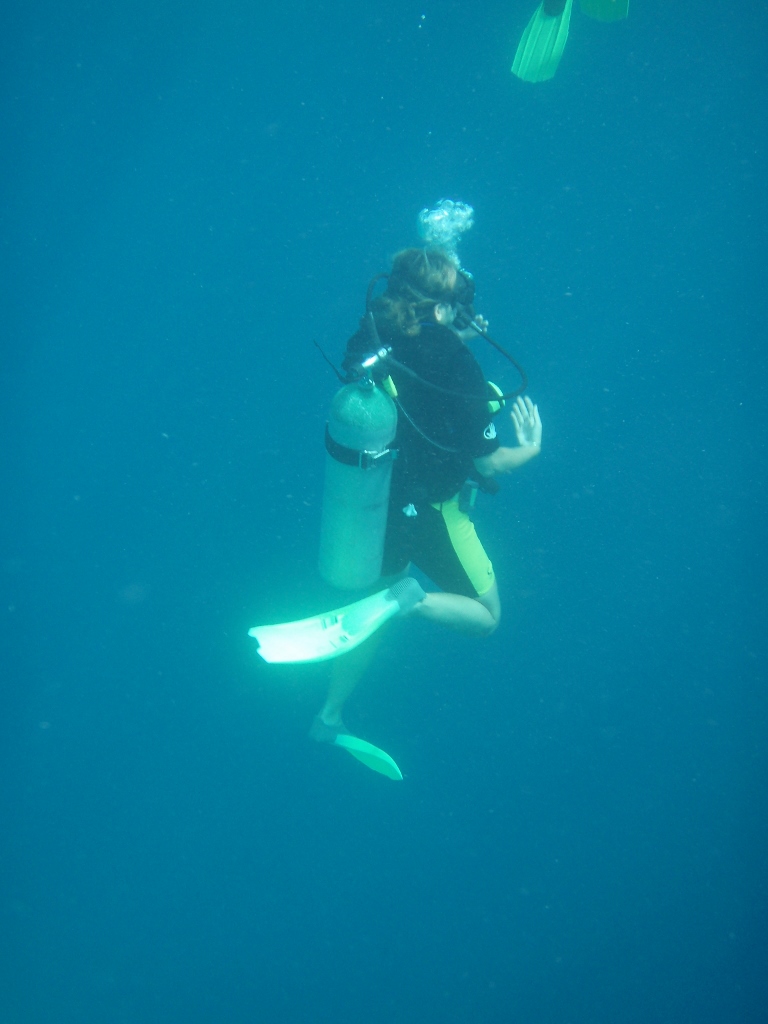 Girl diving towards the depths of the Great Blue Hole
Girl diving towards the depths of the Great Blue Hole
After this, I put my mask, the flippers and the photo-camera back into our speedboat and, while waiting for the scuba divers to return, I spent the rest of the time simply swimming above the Great Blue Hole and enjoying. Not because I felt the place was particularly special, but simply because the sea water was fantastic and pleasantly warm. Enough for one to enjoy.
Meanwhile, a couple of other excursion motorboats came and they parked right next to ours. After a while, the divers from my group finished with their dive and came back to the speedboat where they had something to eat.
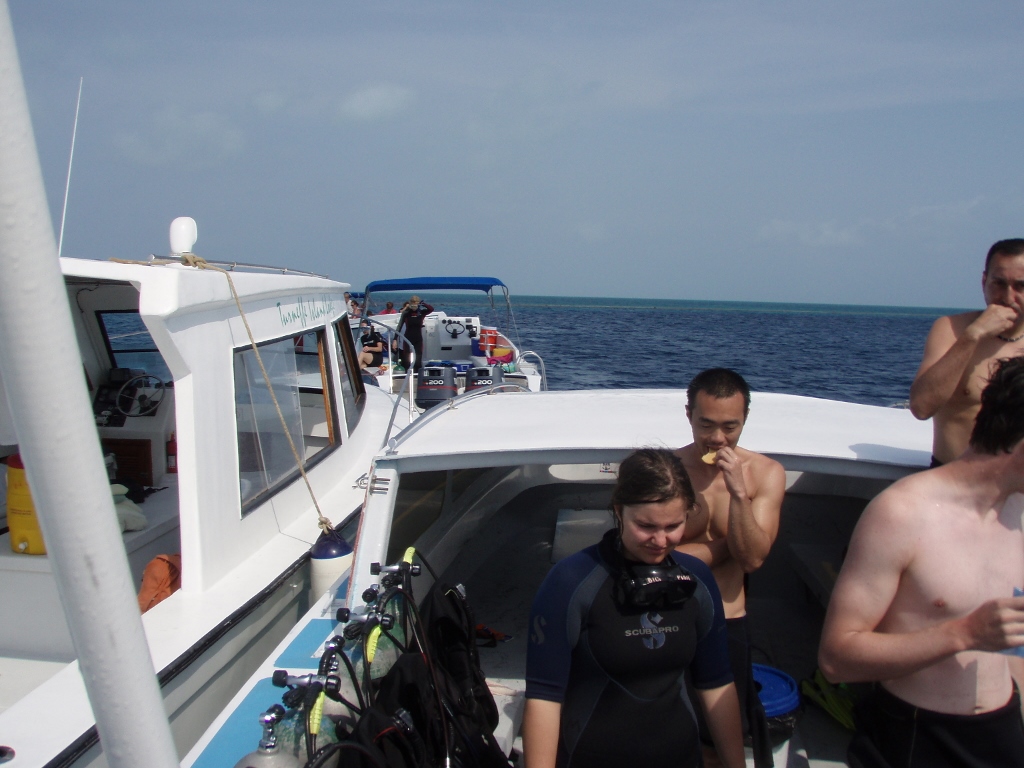 Following the dive in the Great Blue Hole
Following the dive in the Great Blue Hole
So, we finished with our visit to the Great Blue Hole and then we continued with our excursion, remaining within the area of the Lighthouse Reef. This entailed a motorboat ride over the shallow section of the atoll that had a magically wonderful colour.
 Within the Lighthouse Reef atoll
Within the Lighthouse Reef atoll
Some 12 km farther, we got to the other protected area within the Belize Barrier Reef Reserve System that we visited during this excursion and that was the Half Moon Caye Natural Monument. By the way, this “caye” (just like the caye in the name of the island on which I was staying, Caye Caulker), which is written as caye in Belize and somewhat differently in some other places, is a term used for a small, low, sandy island created on the surface of a coral reef. There are such islands in the tropical areas of all the oceans.
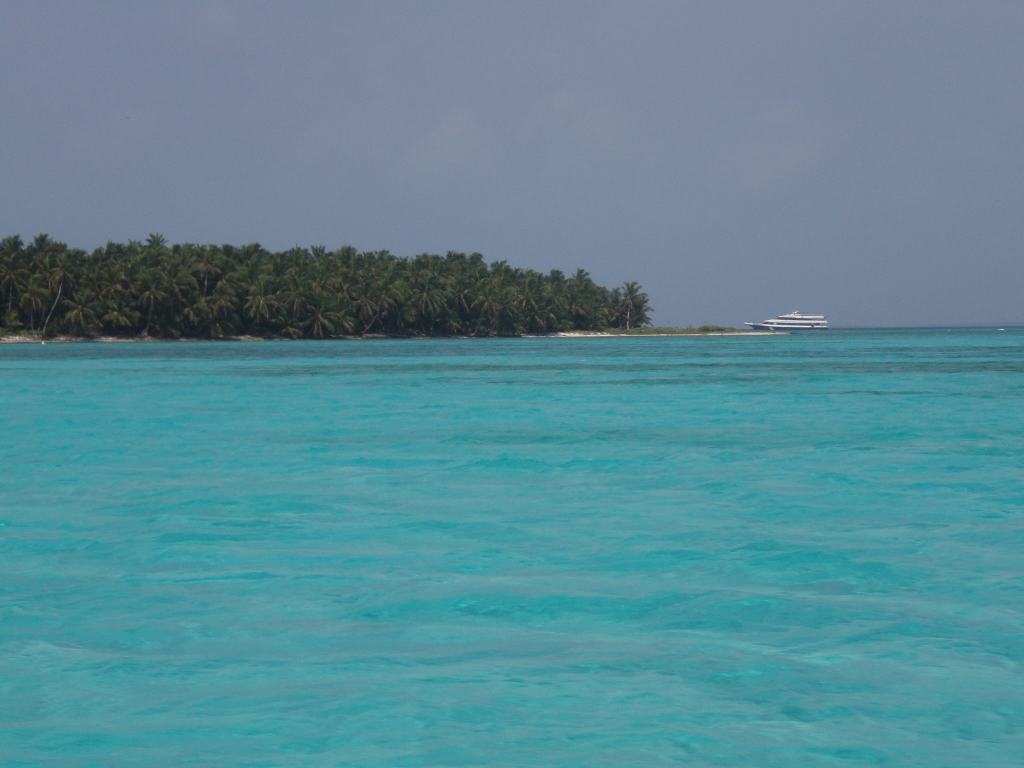 Approaching the Half Moon Caye
Approaching the Half Moon Caye
As for the rest of the name of this tiny island, Half Moon, this is because it has approximately this shape if observed from the bird perspective.
The pilot of the motorboat significantly slowed down here and then approached gradually the wooden pier in order for a couple of us to disembark. The rest, and these were the scuba divers, continued in the motorboat in order to go scuba diving elsewhere.
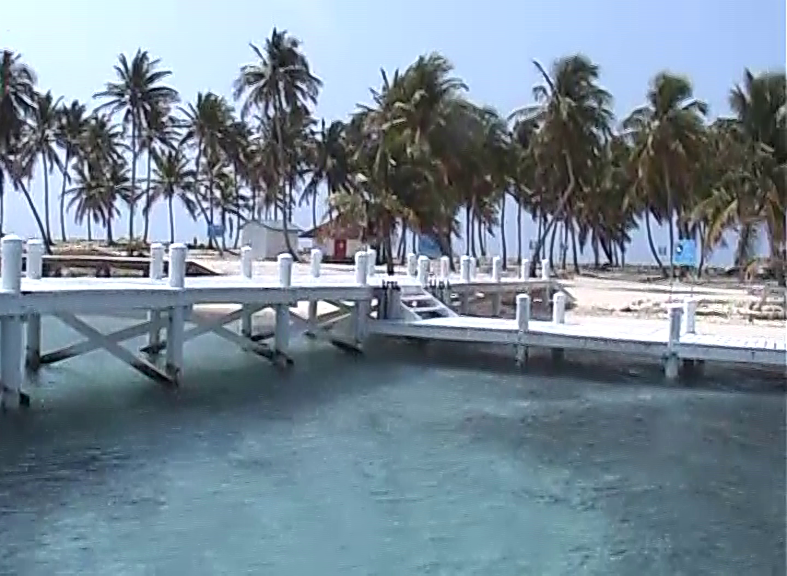 Half Moon Caye, we are disembarking here
Half Moon Caye, we are disembarking here
Once on the dry land, we, the snorkellers, first went for a short walk around the island above which there were numerous frigate birds at the time, but they were far too high, i.e., just too far for me to try to take a photo of them. So instead, I just took a photo of the beach we stepped on first when getting off the pier.
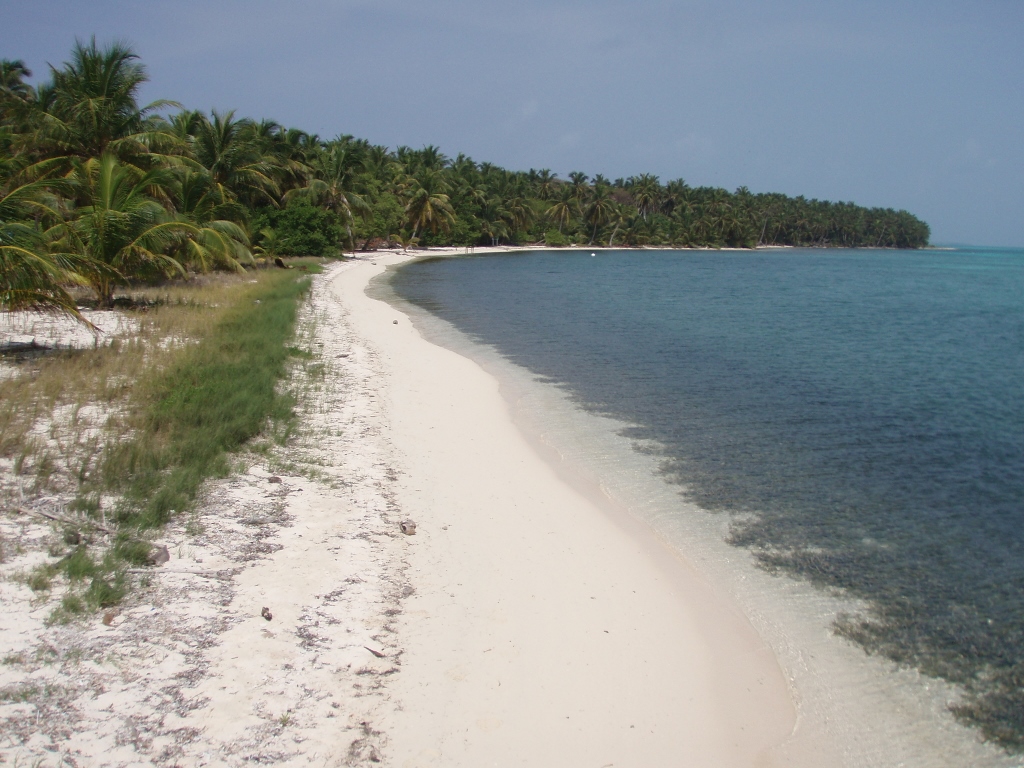 Half Moon Caye
Half Moon Caye
As it may be seen, a large quantity of sea grass starts right here in the shallows, but that was not so important at this point, for the three of us headed for the forest, following a path. Namely, the island is the home of one of the biggest colony of birds, including also the red-footed boobies (Sula sula) that I was particularly interesting in at this time for I had never seen them live before. (In 2019, I had a great opportunity to see them again in Brazil –https://www.svudapodji.com/en/brazil-17/)
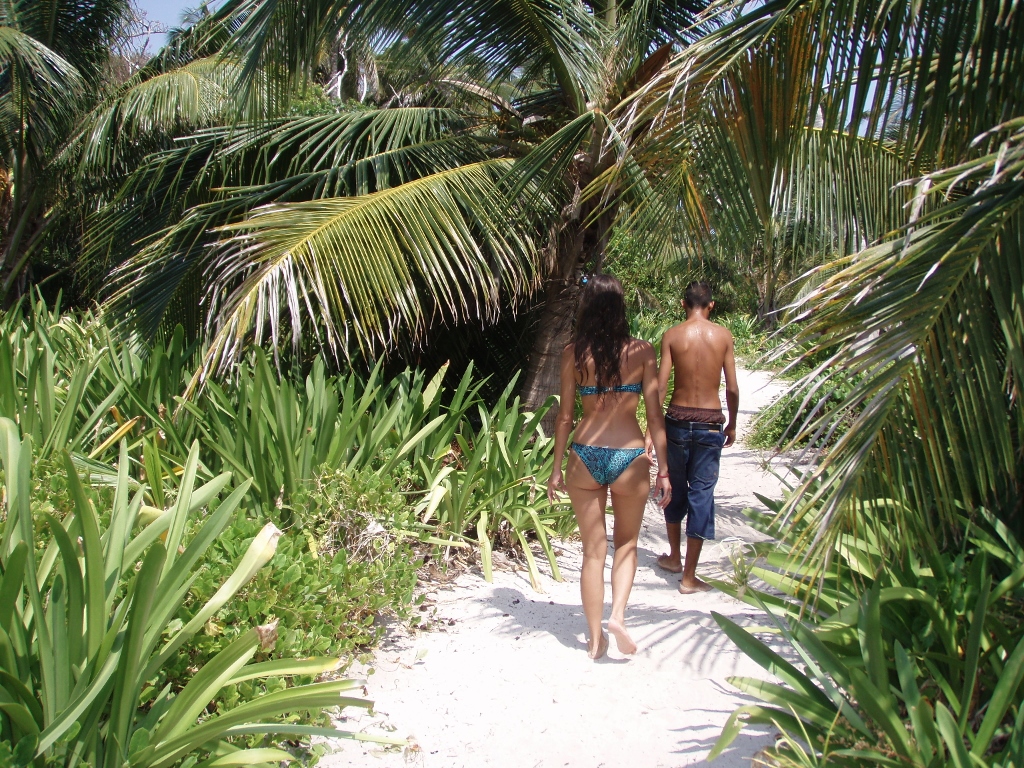 On the way to the bird colony
On the way to the bird colony
In addition to being a natural monument, the Half Moon Caye is also the first nature reserve in Belize, as well as the first marine protected area in Central America. And all of this precisely because the red-footed bobbies’ habitat has been protected here ever since 1924.
Having reached the end of the path, we came across an elevated metal platform that could be ascended by the equally metal stairs. This is an excellent viewpoint for watching the treetops in which the red-footed boobies nest and they also land here in order to keep their plumage neat. They are joined here by frigate birds.
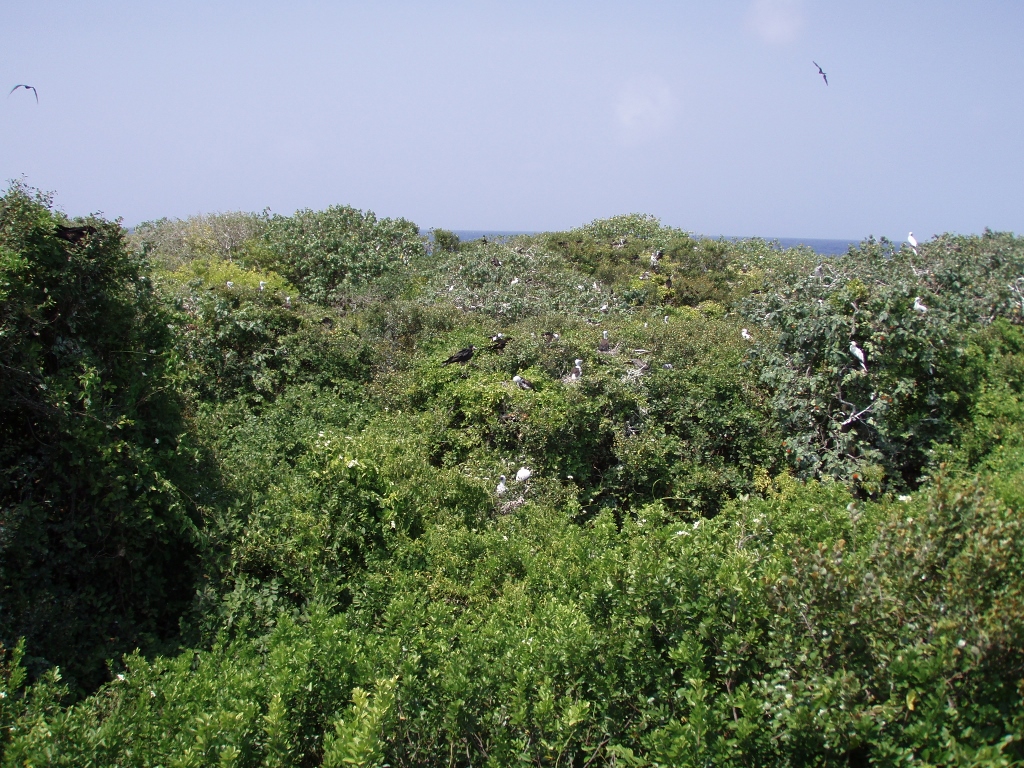 View at the bird colony from the observation platform
View at the bird colony from the observation platform
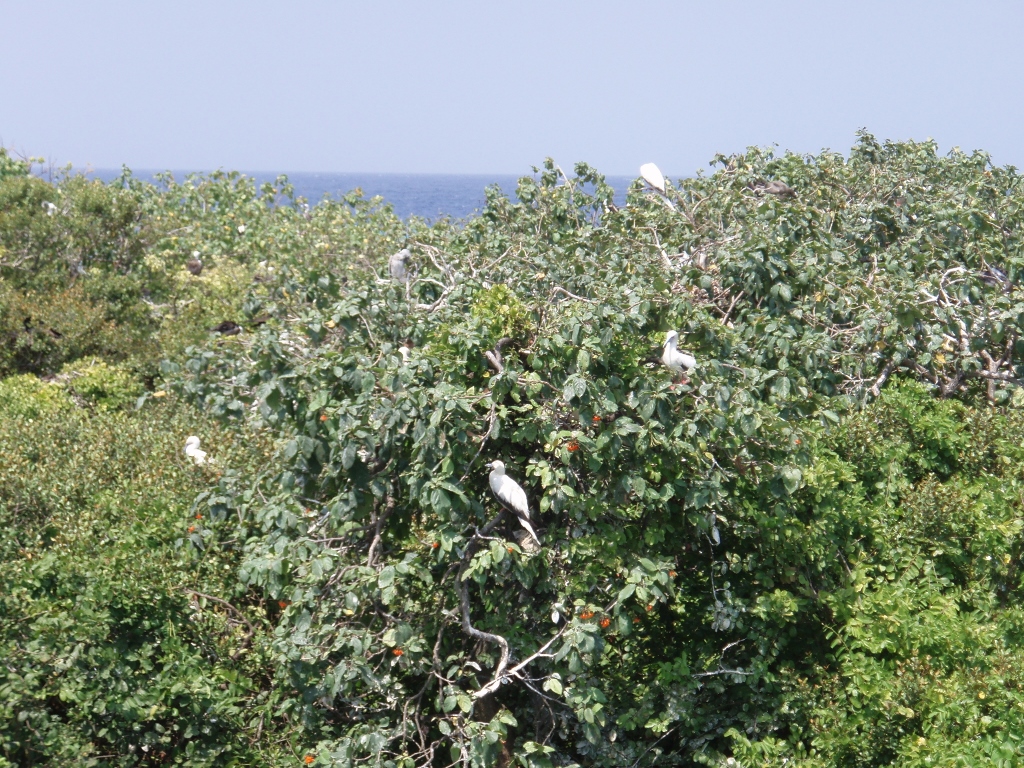 View at the bird colony from the observation platform
View at the bird colony from the observation platform
My photo-camera could not zoom in the birds any more, so I had to do that using my video camera.
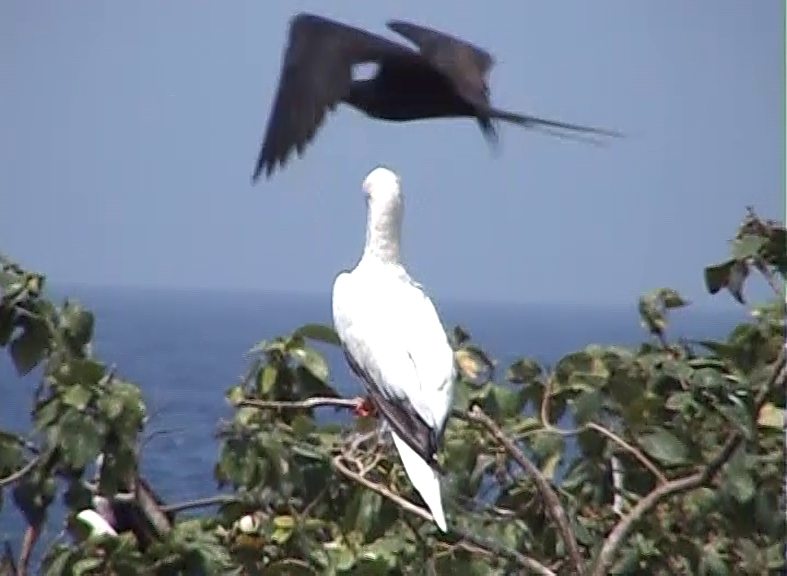 Red-footed booby seen from the back, with a frigate bird flying in front of it
Red-footed booby seen from the back, with a frigate bird flying in front of it
When they clean their plumage, the red-footed boobies tend to place their heads all the way to the back, so depending on the angle, it may seem as if there is only the body and no head.
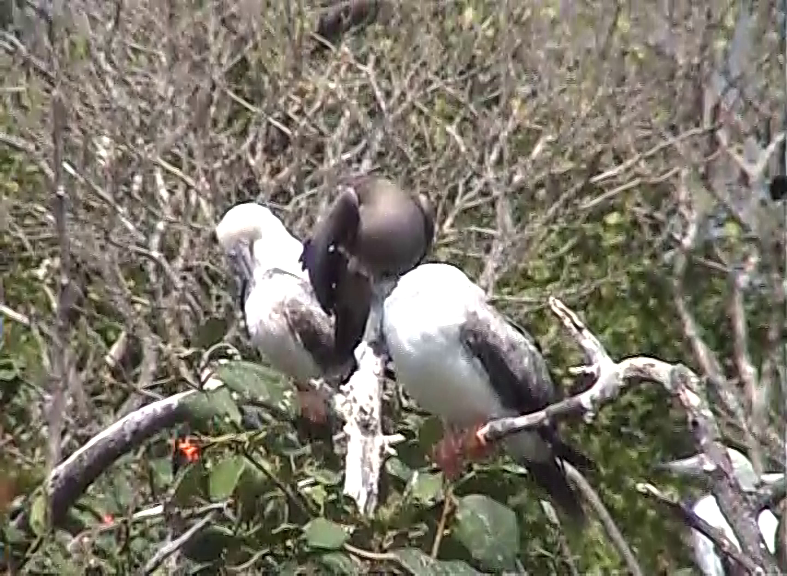 “Headless” booby in the foreground
“Headless” booby in the foreground
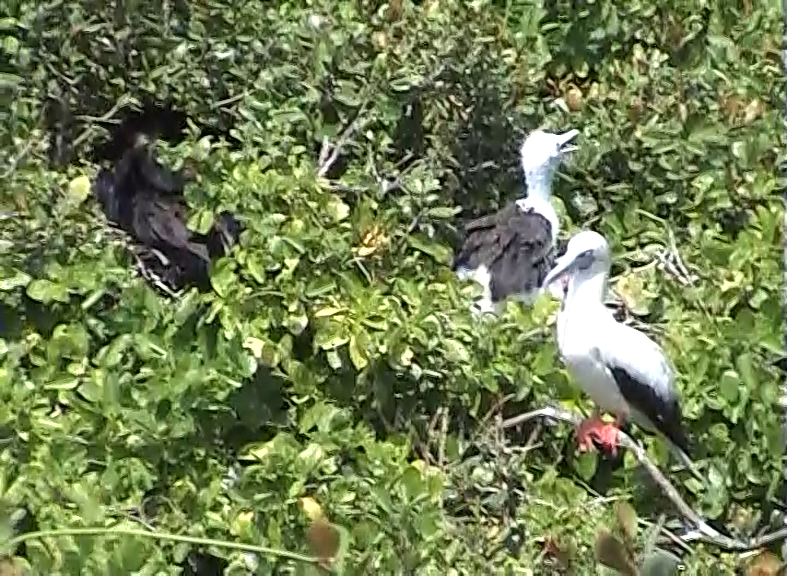 One frigate bird (left) and two red-footed boobies (right)
One frigate bird (left) and two red-footed boobies (right)
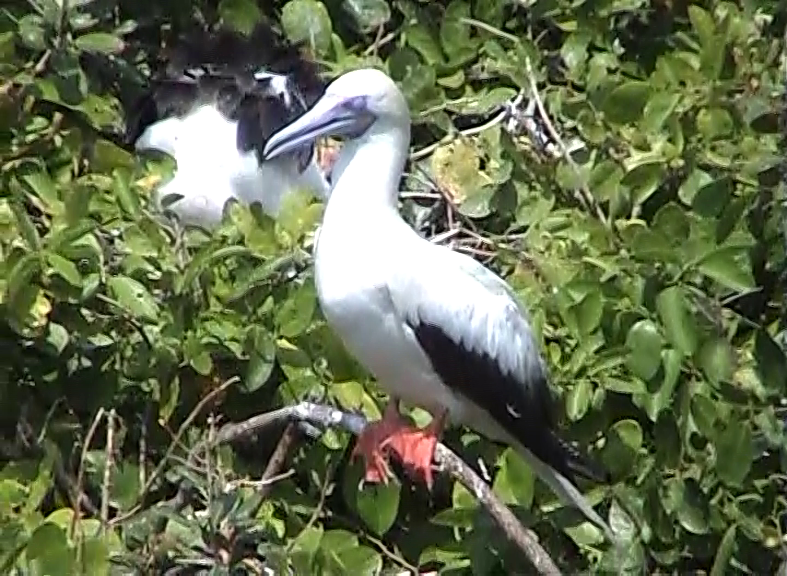 Finally, here is a red-footed booby with both the head and the feet visible
Finally, here is a red-footed booby with both the head and the feet visible
Still, my main problem here was not linked to the photo equipment at all, but to the fact that I came here barefoot, while the metal platform was completely exposed to the sun and consequently extremely hot. The soles of my feet were burning. So, I tried to finish with the watching and taking photos of the birds as soon as possible and move away from there.
While we were going back through the woods, in one spot I took a fine photo of the island’s ground where it can be seen that there are petrified corals mixed with sand. Needless to say, over time there are also falling leaves which then rot and mix with the sand, but particularly where the birds nest there is also a large quantity of the guano, the excrement of seabirds, which is an excellent fertiliser, so the forest can develop very well here.
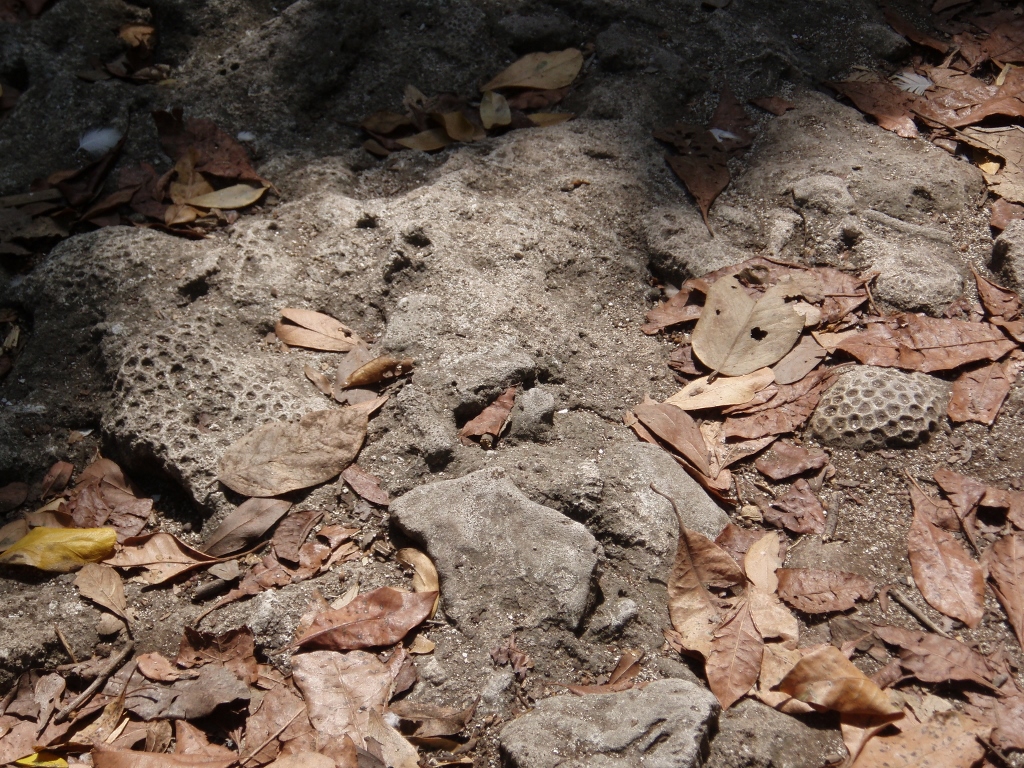 Ground on the Half Moon Caye
Ground on the Half Moon Caye
Of course, there are coconut palms and the coconuts themselves, so they also give their contribution to the maintenance of this small eco-system. Namely, the total length of the island is slightly more than 1 km.
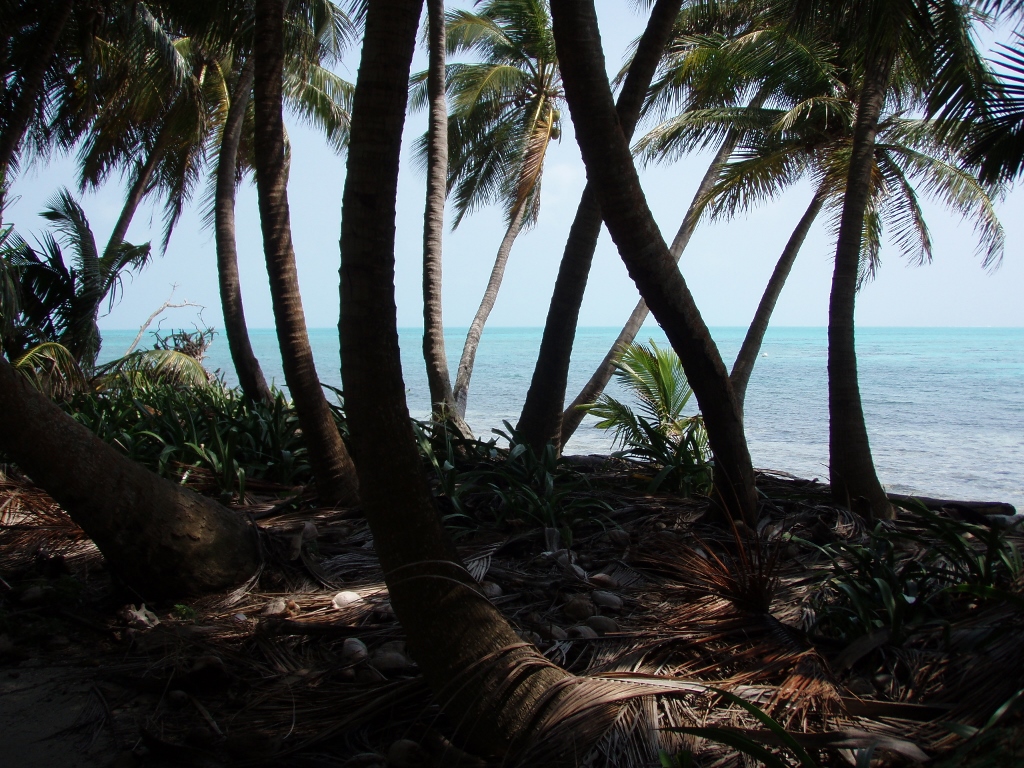 Coconut palms on the Half Moon Caye
Coconut palms on the Half Moon Caye
And then this Argentinian girl who disembarked along with me (there were two of them – one was a proper scuba diver and the other one, like me, only interested in snorkelling), the guy in charge of us and I went to get our equipment and walked some more to the part of the island with a nice place for snorkelling. There the two of us, led by this guy, entered the water and my underwater photo-camera again played its important part.
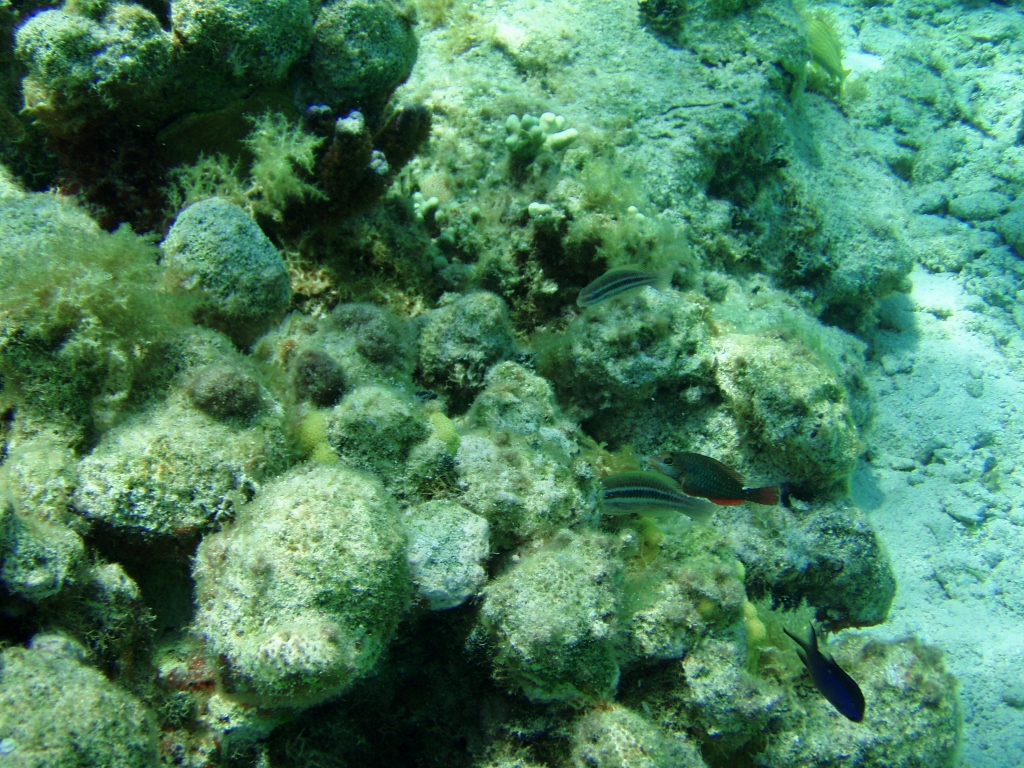 Part of the coral reef by the Half Moon Caye
Part of the coral reef by the Half Moon Caye
I must admit that I was slightly disappointed for I expected more colourful fish, but there was nothing I could do. I did not let this discourage me, choosing instead to take photos of whatever was there.
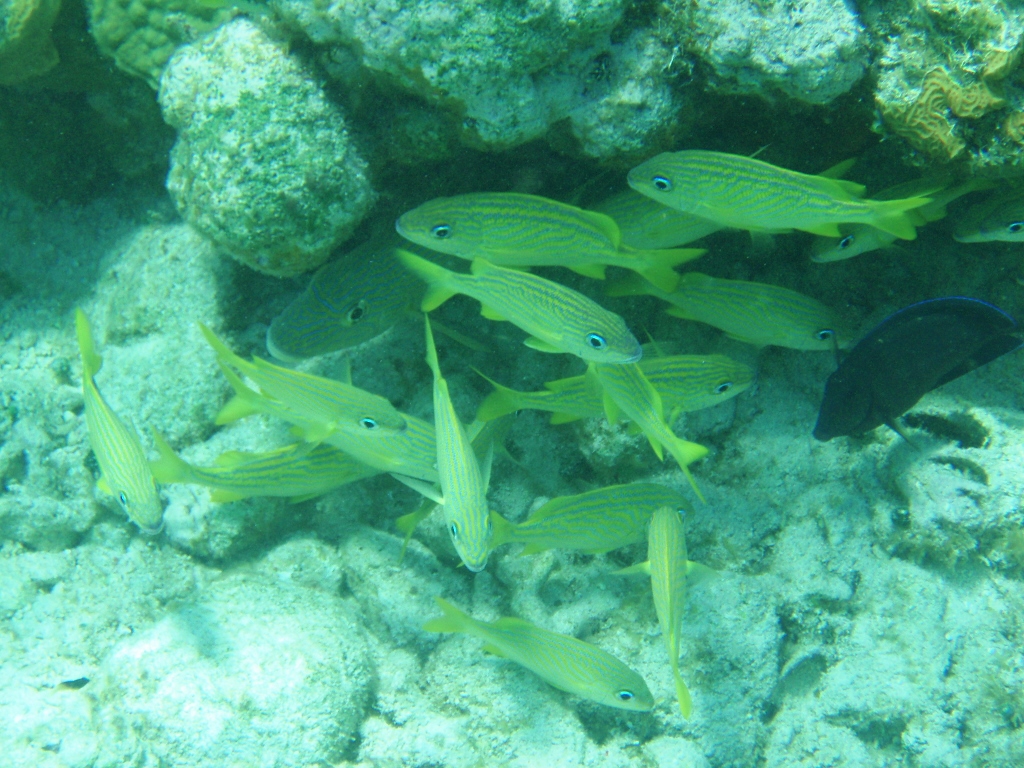 Fish at the coral reef by the Half Moon Caye
Fish at the coral reef by the Half Moon Caye
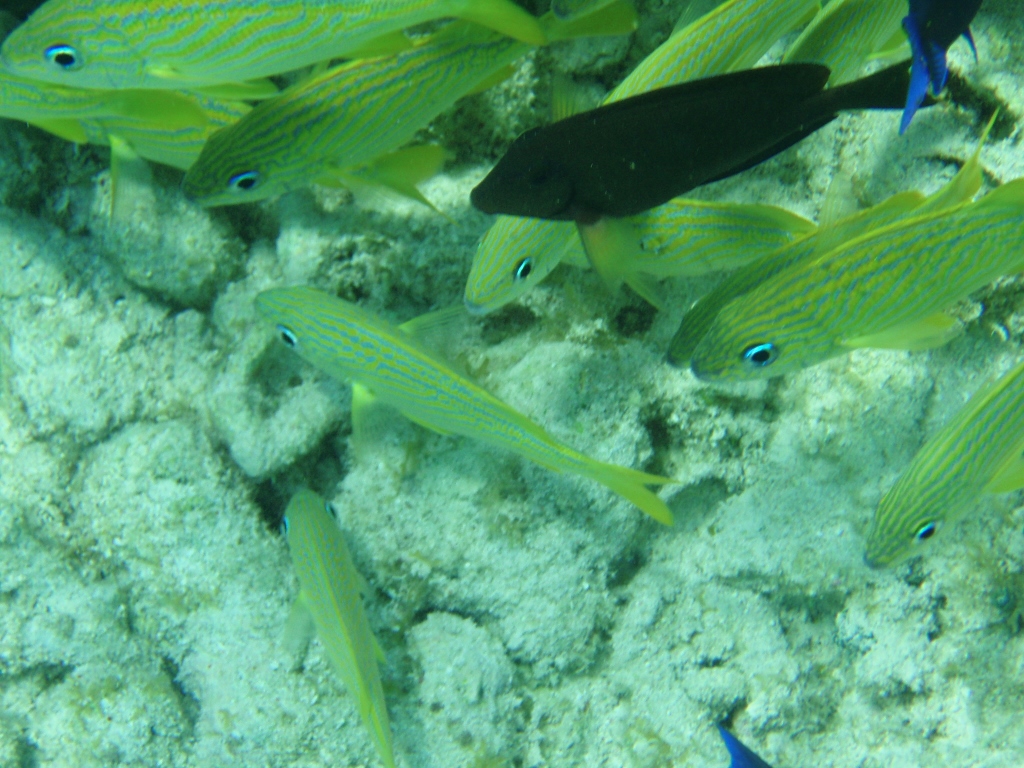 Fish at the coral reef by the Half Moon Caye
Fish at the coral reef by the Half Moon Caye
Then came a fish which I recognised right away. This was a parrotfish, specifically the stoplight parrotfish (Sparisoma viride).
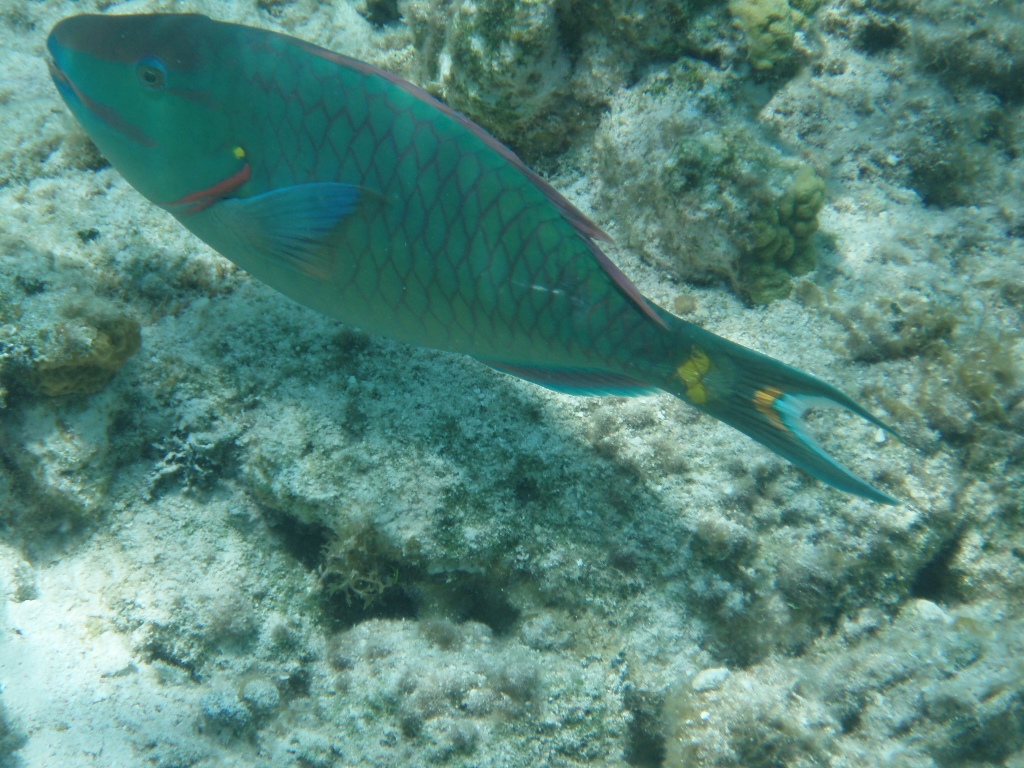 Stoplight parrotfish
Stoplight parrotfish
The parrotfish are a family of around 95 fish species. What is particularly interesting about this fish is that it is precisely them that produce the coral sand. The parrotfish are mostly herbivores, but some also eat corals and along the way they also grab pieces of the rock to which the corals are attached. Since they have teeth that grow constantly, this is quite feasible, and so with their strong teeth they grind everything they bite off. After they have digested the edible parts of whatever they have chewed, the undigested, but ground parts of the rocks are thrown out in the shape of sand that over time creates small islands and sand beaches. Think about it when you lie comfortably on a nice sandy beach.
I certainly did not lie down here, but rather intensively took photos and posed.
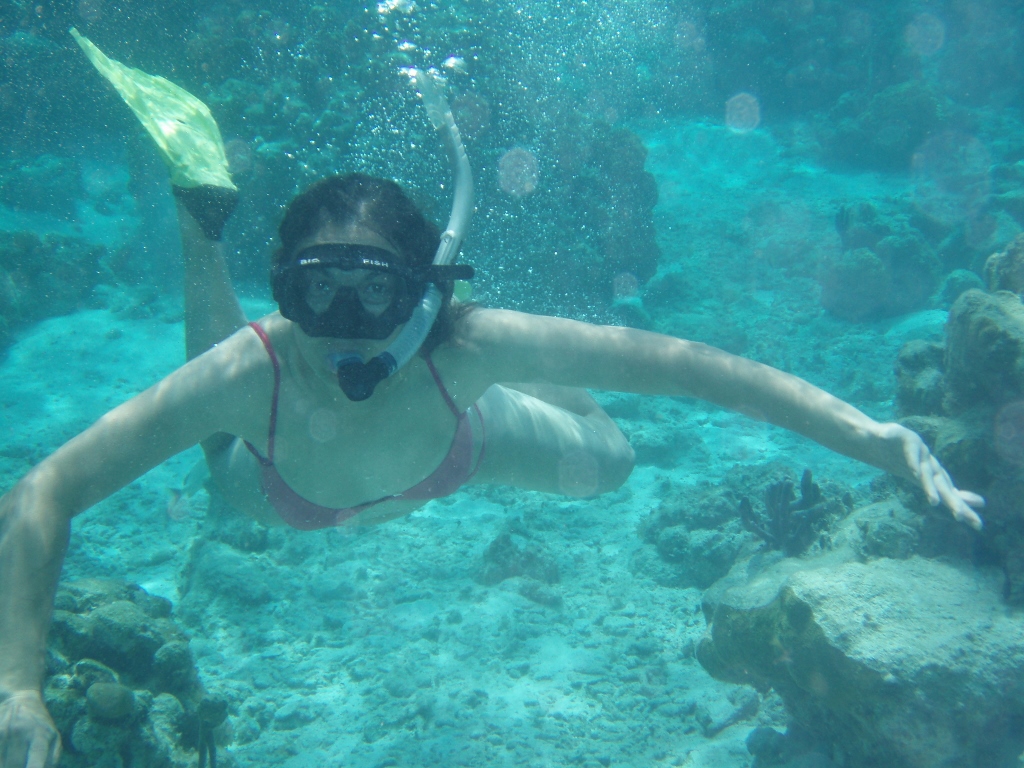 Snorkelling by the Half Moon Caye
Snorkelling by the Half Moon Caye
And then the guy that brought us here pointed for our benefit a couple of sharks resting among the corals. These were the nurse sharks (Ginglymostoma cirratum).
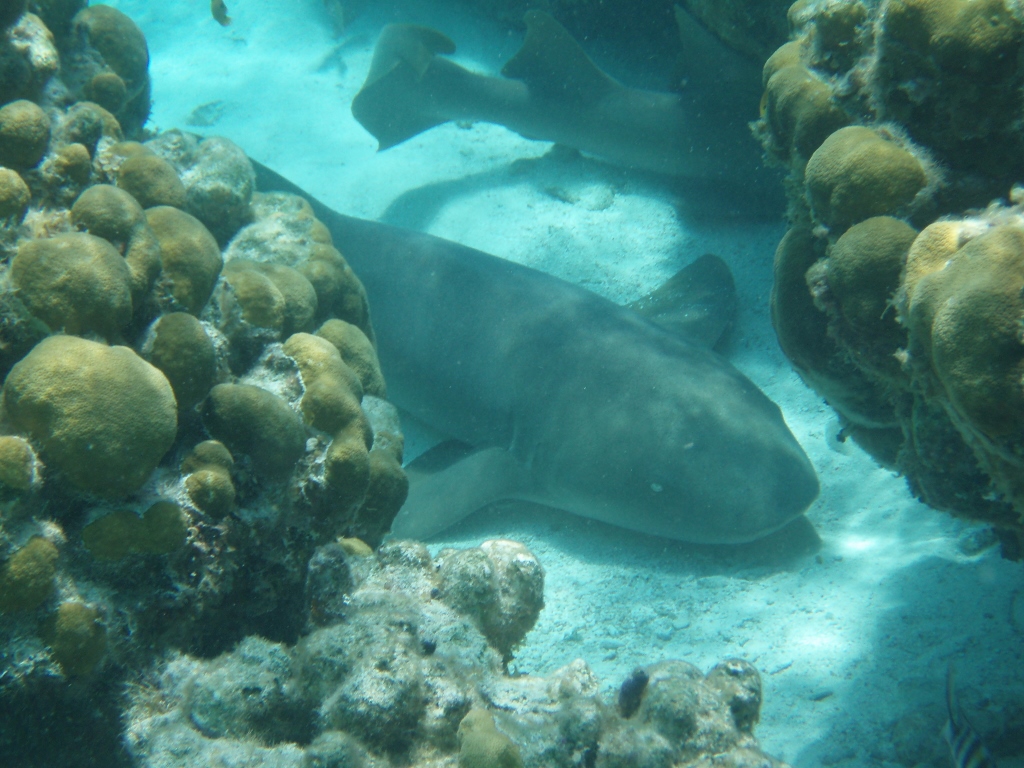 A couple of nurse sharks
A couple of nurse sharks
As opposed to the most of the other shark species, the nurse sharks are exceptionally sedentary and although they appear unthreatening at first sight, according to some records kept on the subject, they are in fact in the fourth position when it comes to the number of humans bitten by sharks. It is presumed that the reason for this lies precisely in their seemingly calm nature which makes people less careful. While I was snorkelling around them, it did seem they were only lying peacefully on the bottom and they only moved a little as if trying to find a better position. Still, they were there long enough for me to take a couple of photos of them, as well as to pose with them in the background, but at a decent distance.
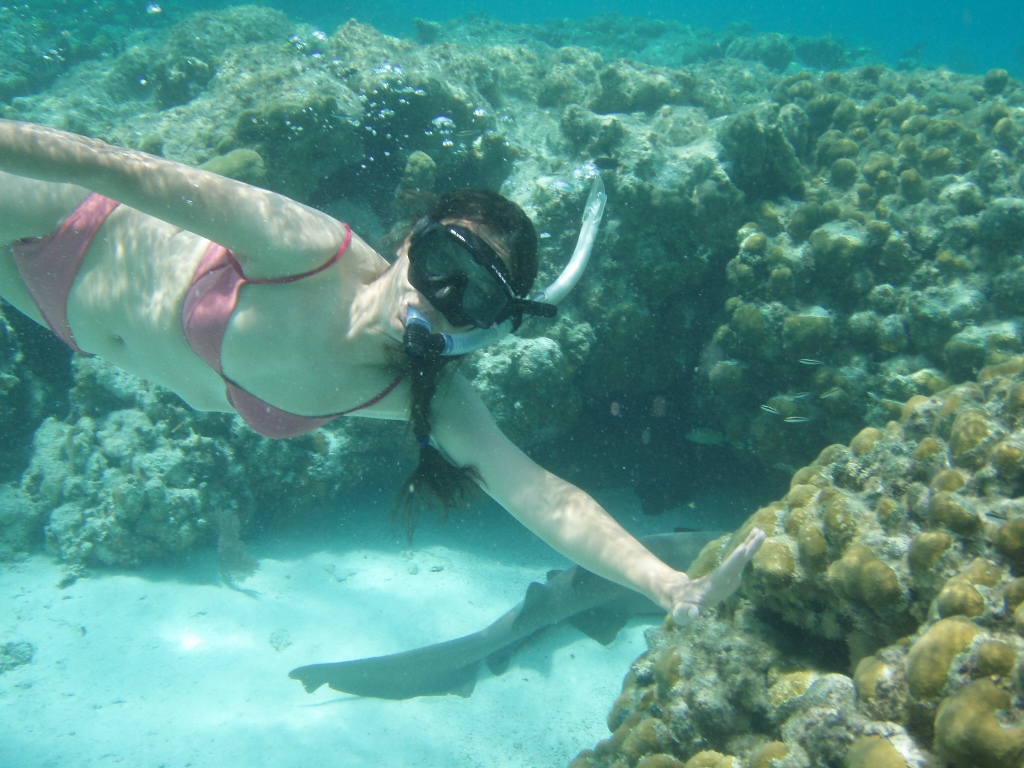 Posing – yes, but disturbing the nurse sharks – no
Posing – yes, but disturbing the nurse sharks – no
I was very content. How could I not be, with all the beauty I was surrounded with and the fantastically clean and clear water.